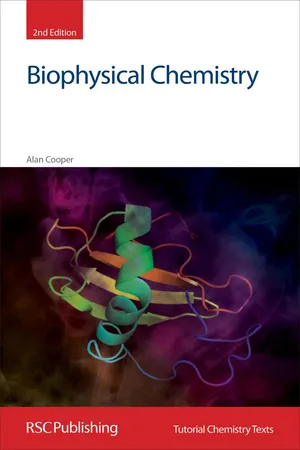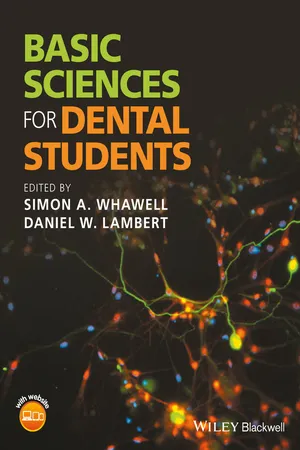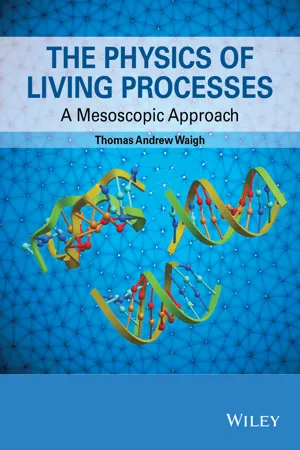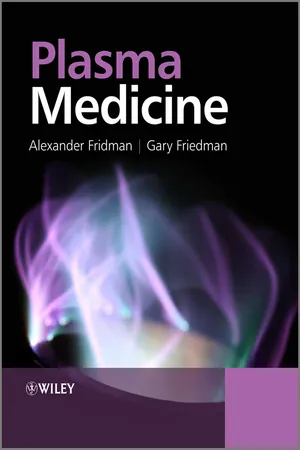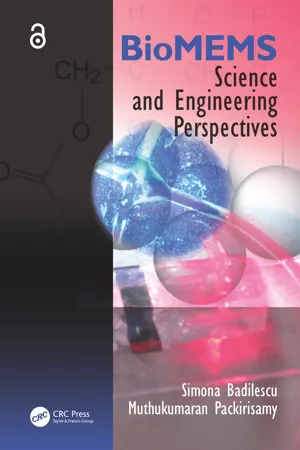Biological Sciences
Biological Molecules
Biological molecules are the building blocks of life, including carbohydrates, lipids, proteins, and nucleic acids. These molecules are essential for various biological processes, such as energy storage, structural support, and genetic information transfer. Understanding the structure and function of biological molecules is crucial for comprehending the complexities of living organisms.
Written by Perlego with AI-assistance
Related key terms
10 Key excerpts on "Biological Molecules"
- eBook - ePub
- Alan Cooper(Author)
- 2015(Publication Date)
- Royal Society of Chemistry(Publisher)
1
Biological Molecules
You don’t need to know any biology in order to study Biological Molecules, but it does help to have some background.Aims This chapter will briefly review the bare bones of biological (macro)molecules. By the end, and together with your previous knowledge and some background reading, you should be able to:- Describe the basic chemical structures of polypeptides, polynucleotides, fats, lipids, and carbohydrates
- Explain what is meant by the primary, secondary, tertiary and quaternary structure of proteins
- Describe the behaviour of fats, lipids and detergents in water
- Explain the anomalous properties of liquid water
- Recall the fundamentals of acid–base equilibrium
1.1 Introduction
This book is mainly about the experimental methods used to understand the physical properties and function of the molecules that make up living systems.These molecules—proteins, polynucleotides, polysaccharides, lipids—are not necessarily any different from molecules we study in other branches of chemistry. But there are some additional factors, arising from their biological origin, which we need to be aware of.- Biological macromolecules are large molecules formed from many smaller units and are (usually) polymers of precise length and specific sequence.
- They (usually) fold or associate into specific conformational assemblies stabilized by non-covalent interactions.
- This (usually) happens in water.
- The molecules are the (usually) successful outcomes of biological evolution.
It is this last point that makes things so exciting for the biophysical chemist. The molecules we see today are the results of countless random (more or less) experiments over millions of years during which living systems have evolved to take advantage of subtle principles of physical chemistry that we barely yet understand. By studying such systems we can learn much about physical chemistry in general, with potential for applications in other areas. - eBook - ePub
- Simon A. Whawell, Daniel W. Lambert, Simon A. Whawell, Daniel W. Lambert(Authors)
- 2017(Publication Date)
- Wiley-Blackwell(Publisher)
1BiomoleculesDaniel W. Lambert and Simon A. WhawellSchool of Clinical Dentistry, University of Sheffield, Sheffield, UKLearning Objectives
- To understand the basis of molecular structure and bonding.
- To outline the basic structure and function of proteins, carbohydrates, lipids and nucleic acids.
- To be able to describe the biological role of enzymes and explain how their activity is regulated.
- To understand basic energy‐yielding pathways and how they are controlled.
Clinical Relevance
An understanding of basic biomolecule structure and function provides a foundation for all normal cell and tissue structure and physiology. The structure of biomolecules present in the human body closely relates to their function, as is the case for cells and tissues. In disease, drugs can be used that target specific biochemical pathways, so an appreciation of biochemistry underlies patient care as well as the diagnosis, prognosis and treatment of disease.Introduction
As complex as the human body is, it is heavily dependent on just four atoms for its composition: carbon, hydrogen, nitrogen and oxygen. These atoms form structurally diverse groups of biologically important molecules, their structure always relating to their function in the same way that the cells and tissues of the body are adapted. Biomolecules commonly take part in relatively simple reactions which are subject to complex control to finely tune the essential processes that they mediate. Biomolecules are often large polymers made up from smaller molecular monomers and even though there are thousands of molecules in a cell there are relatively few major biomolecule classes. Fatty acids, monosaccharides, amino acids and nucleotides form di‐ and triglycerides, polysaccharides, proteins and nucleic acids respectively. Small molecules are also important to biology, as we will see; adenosine triphosphate (ATP), for example, stores energy for catabolic and anabolic process and nicotinamide adenine dinucleotide (NADH) is the principle electron donor in the respiratory electron transport chain. - Jason Birkett, John Lester(Authors)
- 2018(Publication Date)
- CRC Press(Publisher)
Chapter 8Biological Molecules
8.1 Introduction
The existence of a cell depends upon its structural components, which maintain its physical integrity, and its functional components, which control its growth, metabolism and reproduction and which regulate these processes. In a great many instances structural and functional roles are closely integrated, even in the simplest cell.The highly ordered, but extremely complex nature of living cells is due to the great variety of organic compounds which may be formed, inherent in the chemical properties of carbon itself. Its ability to form four covalent bonds with other atoms and itself, generating long carbon chains, gives rise to an almost limitless number of possible compounds, including macromolecules with molecular weights as high as 100 million. In all cases, these macromolecules are formed from the linkage, in a series, of smaller molecules, termed monomers, and hence are called polymers. Even if constructed from a pool containing a relatively small number of different types of monomer molecules the number of different possible sequences of these subunits is theoretically very large indeed. If only a small fraction of all of the possible combinations of monomers were to be associated with a distinct structural or functional characteristic of the polymer molecule, this number would be more than sufficient to account for the enormous diversity and complexity of living organisms. There are, however, a large number of characteristics common to all cells, irrespective of their origins, which is indicative of a moderately consistent selection of only a few of the possible combinations in each case, suggesting that cellular chemistry is organized and regulated in a highly precise manner.There is, in addition to the macromolecules, a great variety of other organic compounds which are important by virtue of their role as nutrients and intermediary metabolites. However, this chapter focuses only on those which are unique and integral components of cells—the macromolecules.- eBook - ePub
- Justin P. Lomont, Ian C. Stewart(Authors)
- 2013(Publication Date)
- Visible Ink Press(Publisher)
BIOCHEMISTRY
MOLECULES OF LIFE
What is biochemistry?Biochemistry is the field focused on elucidating and explaining the complex chemical processes that take place in biological systems. It’s a diverse field, drawing on aspects from virtually every other subfield of chemistry to explain the molecular processes that drive living things. Often, biochemists study complex reaction sequences and catalytic processes involving molecules much larger than those routinely encountered in other subfields of chemistry. A few topics commonly encountered in biochemistry include studying how our cells obtain energy, understanding how our genetic material (DNA) dictates who we are, and explaining how our body regulates and stores nutrients from the foods we eat.In what professions is knowledge of biochemistry important?Biochemistry is important for people interested in careers in human medicine, veterinary medicine, dentistry, pharmacy, and food science, as well as research in almost any physical or biological science and many subfields of engineering as well. While this list isn’t all-inclusive, you can see that biochemistry is used by people working in many different areas!Where are biomolecules found?Biomolecules are molecules that are specifically found inside of living things and have some function related to life. This includes molecules found in plants, animals, insects, bacteria, or even viruses (which are often considered not to be “alive” in a technical sense). Biomolecules span a wide range of sizes, some weighing only about 50 atomic mass units (amu), while others weigh millions of amu (see “Atoms and Molecules” to review the definition of amu). They are in our hair, skin, tissues, organs, and just about everywhere else in our bodies too.Cells contain a variety of organelles, which carry out specific functions for the cell to survive. Lipid bilayers separate the organelles from the rest of the cell. - eBook - ePub
The Physics of Living Processes
A Mesoscopic Approach
- Thomas Andrew Waigh(Author)
- 2014(Publication Date)
- Wiley(Publisher)
Furthermore, much of the most useful generic information can be acquired relatively quickly, although complete mastery of even a small area of biochemistry can require a lifetime’s work. This section of the course is normally greeted with a little scepticism by physics undergraduates, since it is more descriptive in style than they are familiar with, and it is the most biologically and chemically demanding section of the course. However it is surprising the mileage that results from learning a small number of key facts, and it is of course impossible to discuss any biological problems whatsoever without naming the key players; molecules and cells. Suggested Reading Goodsell, D.S. (2010) The Machinery of Life, Springer. A simple discursive introduction to biochemistry with some attractive illustrations. The book includes a gallery of pen and ink drawings of different biomolecules. I particularly liked the perspective of the congested environment inside cells. Goodsell, D.S. (2004) Bionanotechnology: Lessons from Nature, Wiley-Blackwell. Another excellent book from Goodsell, similar in style to The Machinery of Life. 1 Molecules It is impossible to pack a complete biochemistry course into a single introductory chapter. Some of the basic properties of the structure of simple biological macromolecules will therefore be covered. The aim of this chapter is to give the reader a basic grounding in the rich variety of molecules that life presents and some respect for the extreme complexity of the chemistry of Biological Molecules in a wide range of cellular processes. Cells are predominantly composed of water that is structured and organised by inorganic ions and carbon containing (organic) molecules. The extracellular matrix in organisms can, in addition, contain solid crystalline composites such as calcium carbonate and silicates that form bones and exoskeletons - eBook - ePub
- Roger Tim Haug(Author)
- 2019(Publication Date)
- CRC Press(Publisher)
11Biochemistry and Bioenergetics (The Molecules of Life)We can see that there is an underlying simplicity in the molecular organization of the cell; its thousands of different macromolecules are constructed from only a few simple building-block molecules. Albert Lehninger (1970)May the proton-motive force be with you! Nick Lane (2015)Introduction
Early taxonomists labored long and hard to place an organizational structure to life on Earth. It is an innate human characteristic to file, to organize, and to try to derive underlying simplicity out of seeming chaos. Unfortunately, the Tree of Life was an enormous canopy of leaves (the species) that might be related via the stems, branches, and finally the trunk of the tree. And the number of species is almost beyond comprehension, well over millions and counting because many believe that there are millions yet to be discovered. Each voyage of discovery in the 18th and 19th centuries brought back even more plant and animal species for the taxonomist to puzzle over. Things got considerably more complex when the Kingdoms of fungi, protists, and bacteria were added to the mix.It is ironic that the underlying principles, the foundations of life, were found not in classification schemes of the taxonomist, but in the principles of thermodynamics and biochemistry. All living systems and their biomolecules follow the Laws of Thermodynamics. There are no exceptions. There is no “vital force” or other mysterious force that separates the living world from the inanimate world. Living systems extract energy from their environment, use that energy to maintain the essential orderliness necessary for life, and cause the surrounding environment to become more disordered as a result. The other great story of our time is the understanding of life’s basic biochemistry. It turns out that we all share the same basic biochemistry. All of the building-block molecules and the metabolic pathways are essentially the same, from bacteria to man. The molecules used to store and convey energy, to transport electrons, to build proteins, and to store genetic information are the same for all life on Earth. What a story! - eBook - ePub
Coulson and Richardson's Chemical Engineering
Volume 3A: Chemical and Biochemical Reactors and Reaction Engineering
- R. Ravi, R. Vinu, S. N. Gummadi(Authors)
- 2017(Publication Date)
- Butterworth-Heinemann(Publisher)
Chapter 5Fundamentals of Biological Sciences
Sathyanarayana N. Gummadi Indian Institute of Technology Madras, Chennai, IndiaAbstract
Living organisms are chemically complex and capable of performing a wide variety of chemical transformations, which could be manipulated by controlling their environment or by their genetic constitution. To utilize the microorganisms for industrial purposes, a detailed knowledge on the fundamentals of the living organisms is necessary. Biological systems are made up of biomolecules such as proteins, nucleic acids, carbohydrates, and lipids, which work together by wide network of complex biochemical reactions catalyzed by biocatalysts (enzymes) for proper growth, survival, reproduction, and metabolism of the cell. Glycolysis, Kreb's cycle, pentose phosphate pathway, electron transport chain, and photosynthesis are some of the crucial metabolic pathways in the cell. Industrial metabolites such as ethanol, citric acid, antibiotics, active pharmaceutical intermediates can be produced economically using microbial fermentation or using enzymes from variety of substrates (reactants). These microbial or enzymatic reactions are milder in terms of temperature, pH, and pressure when compared to chemical processes. Controlling and manipulation of the metabolic mechanism on microorganisms and protein engineering on enzymes could enable us to specifically enhance the yield of industrially important metabolites. In this chapter, fundamentals of biomolecules, basic concepts of microbiology, cellular metabolism, enzymes, and control and manipulation of metabolic pathways are discussed. - eBook - ePub
- Volodymyr Ivanov(Author)
- 2020(Publication Date)
- CRC Press(Publisher)
2Biomolecules
Chemical Features of Life
The major chemical features of life are as follows:- 1. Such elements as H, C, N, O, P, and S are major elements of live matter (biomass). Carbon is the most important element. It chemically bonds to other atoms in a number of ways to produce biomolecules.
- 2. Many molecules in biomass are specific stereoisomers, that is, molecules having the same structural formulas but where one is the mirror image of the other, just as the left hand is a mirror image of the right hand.
- 3. The same types of biomolecules can be found in all forms of life, from bacteria to humans.
- 4. Biomolecules include such groups of monomers as monosaccharides, aminoacids, and nucleotides, which are used for the synthesis of polysaccharides, proteins, and nucleic acids (RNA and DNA), respectively.
- 5. All biochemical reactions are accelerated by protein catalysts called enzymes.
- 6. Nucleic acids carry genetic information and are used as tools for the biosynthesis of enzymes.
Balance of Elements
The balance of only four atoms – C, H, O, and N – can be accounted for in biotechnological calculations. For example, the most common empirical formula of biomass is CH1.7 O0.5 N0.12 . By the mass conservation law, elements do not disappear in biochemical reactions. So, all equations must be balanced by elements. For example, the aerobic biosynthesis of biomass from glucose (empirical formula C6 H12 O6 ) can be described by the balanced equation:C 6H12O 6+ 8.1O 2+ 0.36 NH 3→ 3 CH1.7O0.5N+ 3 C0.12O 2+ 4.35H 2OCovalent Bonds
The sharing of electrons between atoms constitutes a chemical bond. If electrons are shared equally, the bond is covalent, usually shown as C–C, C–N, C–O (a solid line represents a covalent bond). Covalent bonds can also be double or triple, shown as C=C, C=O or C≡C, respectively. - eBook - ePub
- Alexander Fridman, Gary Friedman(Authors)
- 2012(Publication Date)
- Wiley(Publisher)
In contrast to releasing energy in the form of heat, living systems often convert the energy of the redox reaction into other forms including electrostatic; this is the case in cellular respiration when electrons are transported across membranes of intracellular organelles (mitochondria). In fact, it appears that plasma treatment interacts with cells and tissues at least in part by directly or indirectly influencing redox reactions in cells and cellular respiration.3.1.2 Main classes of organic molecules in living systemsIn living systems there are four main classes of macromolecules that perform a variety of functions: (1) carbohydrates and sugars; (2) lipids (fats and oils); (3) polypeptides (proteins); and (4) nucleic acids.3.1.2.1 CarbohydratesCarbohydrates (synonymous with saccharides in biochemistry) consist of carbon, oxygen and hydrogen where the number of hydrogen atoms is about twice as large as the number of oxygen atoms which, in turn, is about the same as the number of carbon atoms. Carbohydrates are used for a relatively short-term and intermediate-term energy storage (starch for plants and glycogen for animals). They are also employed as structural components in some cells (cellulose in the cell walls of plants and many protists and chitin in the exoskeleton of insects and other arthropods).Sugars are structurally the simplest carbohydrates. They are the key building materials that make up other types of carbohydrates. Monosaccharides (see examples in Figure 3.3 ) are the simplest and smallest sugar molecules with a formula [CH2 O]n , where n is typically between 3 and 6. Some important monosaccharides include ribose (C5 H10 O5 ), glucose (C6 H12 O6 ), and fructose. We classify monosaccharides by the number of carbon atoms, the arrangement of atoms (molecules that have the same chemical formula but different atomic arrangements are called isomers) and the types of functional groups present in them. For example, glucose and fructose (illustrated in Figure 3.3 ) have the same chemical formula (C6 H12 O6 ), but a different structure. Glucose has an aldehyde (internal hydroxyl shown as –OH) and fructose has a keto group (internal double-bond O, shown as =O). This functional group difference, as small as it seems, accounts for the greater sweetness of fructose as compared to glucose. In an aqueous solution, glucose tends to have two isomer structures, α - and β -, with an intermediate straight-chain form (shown in Figure 3.3 - eBook - ePub
BioMEMS
Science and Engineering Perspectives
- Simona Badilescu, Muthukumaran Packirisamy(Authors)
- 2016(Publication Date)
- CRC Press(Publisher)
3 Biomolecules and Complex Biological EntitiesStructure and Properties
BioMEMS devices deal with biomolecular species from the molecular level to the cellular level, as seen in Chapter 1 . The interaction between the devices and biospecies differs so much, depending upon their size and nature. Hence, it is important to understand the structure and nature of different biospecies that would interact with microsystems.3.1 AMINO ACIDSAmino acids play central roles both as building blocks of proteins and as intermediates in metabolism. Proteins are created by polymerization of amino acids, a process in which amino acids are joined to form chains called peptides or polypeptides. The primary structure of a protein refers to the nature of the sequence of amino acids that makes up the protein. The biological activity of proteins is determined by the properties of amino acids that constitute protein composition. The formation of proteins from amino acid building blocks is shown in Figure 3.1 .Proteins are important, not only because they catalyze all of the reactions in living cells, but also due to their role in controlling virtually all the cellular processes. Proteins act as catalysts, regulate transport across cell membranes, and control expression of genes and replication of genetic material. In addition, proteins contain the information regarding the folding of protein into a three-dimensional structure, as well as the stability of this structure within their amino acid sequences. The protein’s specific function in the body is determined by its three-dimensional shape, which results from the sequence of amino acids. In addition to their function in the formation of proteins, amino acids have many other biologically important roles. For example, amino acids such as glycine and glutamate, which are found in most proteins, also function as neurotransmitters that inhibit and amplify, respectively, the transmission of nerve impulses in cells. A nonstandard amino acid called carnitine transports fatty acids into muscle cells for energy production. Many amino acids are used to synthesize molecules other than proteins. For example, tryptophan, an essential amino acid found in proteins such as casein and fibrin, is a precursor of serotonin, which is a neurotransmitter important for the regulation of mood. On the other hand, glycine takes part in the biosynthesis of porphyrins such as heme,
Learn about this page
Index pages curate the most relevant extracts from our library of academic textbooks. They’ve been created using an in-house natural language model (NLM), each adding context and meaning to key research topics.
